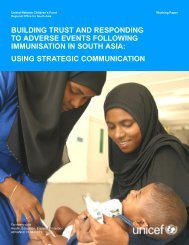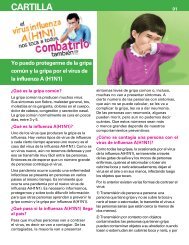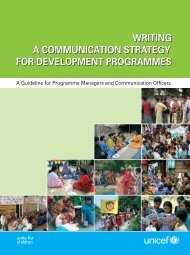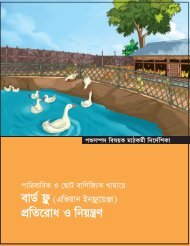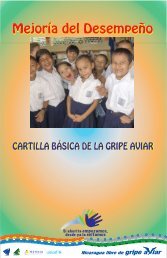FAO-OIE-WHO Joint Technical Consultation on Avian Influenza at ...
FAO-OIE-WHO Joint Technical Consultation on Avian Influenza at ...
FAO-OIE-WHO Joint Technical Consultation on Avian Influenza at ...
- No tags were found...
You also want an ePaper? Increase the reach of your titles
YUMPU automatically turns print PDFs into web optimized ePapers that Google loves.
<str<strong>on</strong>g>FAO</str<strong>on</strong>g>-<str<strong>on</strong>g>OIE</str<strong>on</strong>g>-<str<strong>on</strong>g>WHO</str<strong>on</strong>g> <str<strong>on</strong>g>Joint</str<strong>on</strong>g> <str<strong>on</strong>g>Technical</str<strong>on</strong>g> <str<strong>on</strong>g>C<strong>on</strong>sult<strong>at</strong>i<strong>on</strong></str<strong>on</strong>g> <strong>on</strong> <strong>Avian</strong> <strong>Influenza</strong> <strong>at</strong> the Human-Animal InterfaceAIVs to farms and are a source for human infecti<strong>on</strong>, andare therefore a useful site for targeted surveillance. It wasnoted th<strong>at</strong>, in an affected country, virus c<strong>on</strong>centr<strong>at</strong>i<strong>on</strong> isgenerally low <strong>at</strong> the farm or household level, increases <strong>at</strong>wholesale markets, and is further amplified and sustained<strong>at</strong> LBMs from where virus may be dissemin<strong>at</strong>ed back tofarms and households.D<strong>at</strong>a from different countries was presented. Risk factorsfor LBM c<strong>on</strong>tamin<strong>at</strong>i<strong>on</strong> included housing of unsold poultryovernight, presence of Muscovy ducks, presence of a largeduck popul<strong>at</strong>i<strong>on</strong>, and slaughtering in multipurpose areasand in stalls. Human risk <strong>at</strong> LBMs was associ<strong>at</strong>ed with thepresence of restaurants and food stalls in markets, havingfamily members in the market, and the use of traditi<strong>on</strong>alslaughtering processes. Viral burden in LBMs was shown tobe decreased by implementing a rest day, removal of particularspecies (e.g., quail), improving market hygiene, andnot allowing live poultry to remain overnight. However,LBMs must be specifically assessed as they vary gre<strong>at</strong>lyam<strong>on</strong>g and within countries and therefore do not all havethe same risk factors.It was discussed th<strong>at</strong> in many countries LBMs play animportant role in people’s cultural and ec<strong>on</strong>omic lives, andthus appropri<strong>at</strong>e and culturally sensitive ways to decreaseassoci<strong>at</strong>ed AI risks must be sought. Specific targeted assessmentsof LBMs would allow understanding of the envir<strong>on</strong>mentalc<strong>on</strong>tamin<strong>at</strong>i<strong>on</strong> of different areas within LBMs andam<strong>on</strong>g LBMs in different settings, communities, and countries.Having decisive political support would allow the animaland public health sectors to develop appropri<strong>at</strong>estr<strong>at</strong>egies, regul<strong>at</strong>ory frameworks and guidance. Measuresto decrease risks could then be integr<strong>at</strong>ed into n<strong>at</strong>i<strong>on</strong>al systemsto improve the general hygiene of LBMs and reducerisks for AIV and other animal and zo<strong>on</strong>otic p<strong>at</strong>hogens.C<strong>on</strong>tamin<strong>at</strong>i<strong>on</strong> of envir<strong>on</strong>ments can be heavy duringpoultry outbreaks, with virus being isol<strong>at</strong>ed from households,wet feces, p<strong>on</strong>d w<strong>at</strong>er, mud under animal cages, soil(including th<strong>at</strong> bene<strong>at</strong>h houses <strong>on</strong> stilts), in poultry rangingplaces, and <strong>on</strong> the fe<strong>at</strong>hers of dead poultry. In envir<strong>on</strong>ments,AIVs survive in w<strong>at</strong>er, in feces, and <strong>on</strong> surfaces.Temper<strong>at</strong>ure, porosity of the surface and w<strong>at</strong>er salinity allaffect survival time. More recent H5N1 viruses have beenshown to survive l<strong>on</strong>ger in chicken feces than those virusesfrom 1997, but studies suggest this is due to l<strong>on</strong>ger decaytimes because of higher virus titers within feces and is notan intrinsic resistance of the virus strains to inactiv<strong>at</strong>i<strong>on</strong>.Cultural practices associ<strong>at</strong>ed with riskSome key cultural practices may increase risk to humans.For example, traditi<strong>on</strong>al poultry producti<strong>on</strong> and peoplesharing their living areas with poultry put humans in closeand prol<strong>on</strong>ged c<strong>on</strong>tact with infected animals and c<strong>on</strong>tamin<strong>at</strong>edenvir<strong>on</strong>ments, and cock fighting involves direct c<strong>on</strong>tactwith avian blood and respir<strong>at</strong>ory secreti<strong>on</strong>s. Oftenthese practices are linked with ec<strong>on</strong>omics (household poultryturning household waste into inexpensive protein, duckfarmers paying rice farmers to allow ducks to feed <strong>on</strong> leftover rice); practicality (food stalls and family membershelping in LBMs; eggs and poultry available in householdor village); necessity (LBM and household slaughterrequired when no available cold chain; workers staying inpoultry house to protect poultry); cultures and beliefs(entertainment and prestige of cock fighting; believing inbad luck or karma as cause of outbreaks). It was suggestedth<strong>at</strong> extensive public awareness campaigns and communic<strong>at</strong>i<strong>on</strong>may improve public knowledge but not changepractices due to the c<strong>on</strong>sider<strong>at</strong>i<strong>on</strong>s described above. It wasemphasized th<strong>at</strong> cultural issues are complic<strong>at</strong>ed and taketime to change, requiring an integr<strong>at</strong>ed package of interventi<strong>on</strong>s,educ<strong>at</strong>i<strong>on</strong>, and work within the community.Poultry systems and management practices associ<strong>at</strong>ed withriskMuch more is known about risk of spread of the virus inanimal popul<strong>at</strong>i<strong>on</strong>s than is known about human zo<strong>on</strong>oticrisk. Because exposure of humans mainly occurs directly orindirectly through infected poultry, it is important tounderstand the risk posed by different poultry popul<strong>at</strong>i<strong>on</strong>s.As well, poultry raising and marketing systems differam<strong>on</strong>g countries and therefore pose different risks. In general,risk of spread am<strong>on</strong>g birds is increased in countriesth<strong>at</strong> have large poultry popul<strong>at</strong>i<strong>on</strong>s, and th<strong>at</strong> produce avariety of avian species in all four <str<strong>on</strong>g>FAO</str<strong>on</strong>g>-defined poultry sectors,8 especially when much of the producti<strong>on</strong> is in smallscale farms or in households. The H5N1 endemic countriestend to have large domestic w<strong>at</strong>erfowl and wild bird popul<strong>at</strong>i<strong>on</strong>s,although the limited available field d<strong>at</strong>a <strong>on</strong> the roleof wild birds in virus spread is difficult to interpret in thec<strong>on</strong>text of reservoirs and infecti<strong>on</strong> dynamics. The diseaseoften has seas<strong>on</strong>al occurrence, with outbreaks generallyoccurring in the winter, due to many factors including riceharvests and holiday festivals as well as we<strong>at</strong>her.Risk of incursi<strong>on</strong> <strong>on</strong>to a farm is determined by theamount of outside c<strong>on</strong>tact and whether it involves possiblyinfected or c<strong>on</strong>tamin<strong>at</strong>ed m<strong>at</strong>erial, the local level of infecti<strong>on</strong>,and biosecurity measures taken. It was noted th<strong>at</strong>even in endemic countries most poultry and loc<strong>at</strong>i<strong>on</strong>s willnot be infected or c<strong>on</strong>tamin<strong>at</strong>ed (with the excepti<strong>on</strong> ofsome LBMs), though each flock will have its own risk profilebased <strong>on</strong> multiple factors, especially biosecurity level.Increasing human popul<strong>at</strong>i<strong>on</strong>s, food prices, and c<strong>on</strong>cernsabout ethical rearing could lead to more poultry raisedoutdoors, which would increase risk for exposure and virusspread.There was some discussi<strong>on</strong> <strong>on</strong> the effects of n<strong>at</strong>urallyacquired influenza immunity <strong>on</strong> infecti<strong>on</strong> dynamics inª 2010 <str<strong>on</strong>g>FAO</str<strong>on</strong>g>, <str<strong>on</strong>g>OIE</str<strong>on</strong>g> and <str<strong>on</strong>g>WHO</str<strong>on</strong>g>, <strong>Influenza</strong> and Other Respir<strong>at</strong>ory Viruses, 4 (Suppl. 1), 1–29 11





